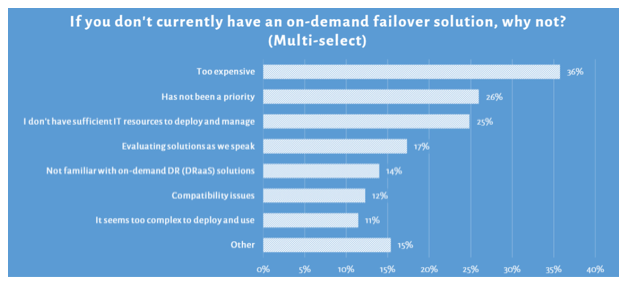Traditionally, disaster recovery has always been sold like “earthquake” insurance--like it’s only for natural disasters. The reality is that 75% of downtime is the result of human error--completely unrelated to natural disasters. This new reality puts businesses in a precarious position as they don’t have any way to mitigate the effects of system downtime.
August 13, 2015

By Infrascale Guest Blog 1
 Traditionally, disaster recovery has always been sold like “earthquake” insurance–like it’s only for natural disasters. The reality is that 75% of downtime is the result of human error–completely unrelated to natural disasters. This new reality puts businesses in a precarious position as they don’t have any way to mitigate the effects of system downtime.
Traditionally, disaster recovery has always been sold like “earthquake” insurance–like it’s only for natural disasters. The reality is that 75% of downtime is the result of human error–completely unrelated to natural disasters. This new reality puts businesses in a precarious position as they don’t have any way to mitigate the effects of system downtime.
Consequently, IT failures have increased in frequency, becoming more the status quo than the anomaly. And, unfortunately, these failures cost 80% of SMBs at least $20,000 per hour (source: IDC). That said, downtime costs vary significantly within industries, especially due to the different types of downtime. A failure of a critical application can lead to a few types of losses:
Loss of the application service: The impact of downtime varies with the application and the business.
Loss of data: The potential loss of data due to a system outage can have significant legal and financial impact.
Given these impacts, it was somewhat surprising to learn this week that only 10% of businesses surveyed could failover critical business applications to a second site within 15 minutes (according to a recent report created by ActiveTech Media, which examined data protection and cloud-based disaster recovery).
Despite the emergence of disaster recovery as a service (DRaaS) solutions, companies have been slow to adopt them because of the perceived high cost of on-demand failover solutions, lack of sufficient IT resources and DRaaS not being a key business priority.

DRaaS has the ability to change the game.
In fact, DRaaS is growing 50% year-over-year and is on pace to become a $12 billion market by 2020. This represents a huge opportunity for VARs and MSPs, but only if they can educate their clients about its benefits and overcome their perceived objections:
Perceived High Cost: Traditionally, DR solutions have been prohibitively expensive, especially if you want rapid second site failover. This usually means setting up additional hardware, configuring a second site for redundancy and architecting a complex replication solution across data centers. Resiliency solutions often require you to manually recover your data, making for an unreliable, time-consuming and complex recovery process. But, this is changing–fast. And new solutions are now available for little more than the cost of backup.
Insufficient IT Resources: Disasters, unpredictable by nature, can strike anywhere at any time with little or no warning. Recovering from one can be stressful, expensive and time consuming, particularly if you haven’t taken the time to think ahead. However, when disaster strikes–either from a minor server outage or a full blown natural disaster–those who have failover capabilities can survive with minimal data loss and disruption of productivity. New failover solutions can spin up and virtualize key applications from your backups, sitting either on the appliance or within the cloud, with just a push of a button.
Not a Business Priority: This is a real head-scratcher, especially in light of the frequency of outages and the business impact of those outages (both financial and operational). How can something that can cost a company thousands of dollars per hour from either man-made or natural disasters not be a Top 3 business priority? If it’s not a priority, it absolutely has to become one–soon. And MSPs can play a powerful role in evangelizing this sea change.
Evangelizing DRaaS begins by examining how your clients are addressing DR right now. If they’re among the 22% of businesses that still rely on tape (or some other physical media) and offsite storage, it’s time to think more holistically about the “recovery” part of the DR equation.
It’s time to embrace DRaaS and ensure your clients can recover from micro and macro-level failures – quickly, affordably and securely. Every business–from startups to established enterprises–need to rethink their DR strategy and make 15-minute failover a reality. You can check out the full state of DR report here.
 Ken Garcia is the director of content marketing at Infrascale. Guest blogs such as this one are published monthly and are part of MSPmentor’s annual platinum sponsorship.
Ken Garcia is the director of content marketing at Infrascale. Guest blogs such as this one are published monthly and are part of MSPmentor’s annual platinum sponsorship.
You May Also Like
